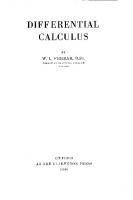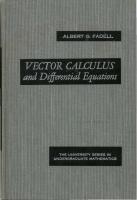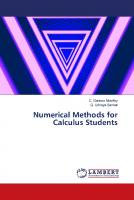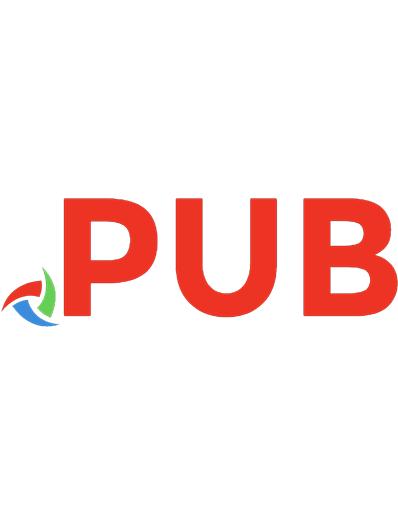Differential Calculus for B.A. and B.Sc students [Tenth ed.]
972 106 16MB
English Pages 424 Year 1962
Polecaj historie
Citation preview
DIFFERENTIAL
CALCULUS
SIIANTI
NARAYAN
DIFFERENTIAL CALCULUS
(Review published in Mathematical Gazette, London, December, 1953
THE
book has reached
can be assumed that
it
Its
meets
5th edition all
in
demands.
9 years and Is
it
the revie-
wer's fancy to discern the influence of G. H. Hardy
opening chapter on clearly dealt with
Or
the
in
numbers, which are well and
real
?
it
this only to
is
be expected from
an author of the race which taught the rest of the world
how
to count
?
*
.-
"i
The course followed and there
is
a
*
*
comprehensive and thorough, v good chapter on curve tracing. The author is
has a talent for clear and exposition,
is
sympathetic to the
difficulties of the beginner.
*
#
*
Answers to examples, of which there are good and ample selections, are given.
*
Certaianly excellent
#
Mr.
Narayan's
Our own young
3
command scientific
of or
English
is
mathematical
grumbling over French or German or Latin as additions to their studies, would do well to consider their
specialist,
Indian
confreres,
with
English
technical education can begin.
to
master
before
their
DIFFERENTIAL CALCULUS FOR B. A.
&
B. Sc.
STUDENTS
By
SHANTI NARAYAN Principal,
and Head of
Hans Raj
the
Department of Mathematics
College, Delhi University
TENTH REVISED EDITION 1962
S.
CHAND &
CO. NEW DELHI BOMBAY JULLUND tTR LUC KNOW
DELHI
Books by the same Author Integral Calculus
Rs.
6'25
Modern Pure Geometry
Rs.
5'00
Analytical Solid
Rs.
5-50
Geometry
A Course of Mathematical Analysis
Rs. 15*00
Theory of Functions of a Complex Variable A Text Book of Matrices
Rs. 12-50
7'50
Rs.
A Text Book of Vector Algebra A Text Book of Vector Calculus A Text Book of Cartesian Tensors A Text Book of Modern Abstract Algebra A Text Book of General Topology (Under preparation)
Rs.
6 50
Rs.
7'50
Rs.
6 50
Rs. 14'00
Published by
CHAND &
S.
for
Shyam
Lai Charitable Trust,
16B/4, Asaf
AH
Ram
Road,
New
Delhi.
book are spent on
(All profits from this
S.
CO.
CHAND
charities.)
CO
& NEW
Nagar
Fountain
DELHI DELHI
BOMBAY
Lamington Road Mai Hiran Gate
JULLUNDUR
LUCKNOW
Lai Bagh
First Edition
1942
Tenth Edition 1962 Price
Published by
G S
Shartna. for S.
:
Rs. 7-00
Chand
Printed at Rajendra Printers.
&
Co.,
Ram
Ram
Nagar,
Nagar,
New
New
Delhi-1*
Delhi and
Preface to the Tenth Edition
The book has been
revised.
A
few more exercises drawn from
the recent university papers have been given.
SHANTI NARAYAN
30th April, 1962.
PREFACE This book is meant for students preparing for the B.A. and Some topics of the Honours B.Sc. examinations of our universities. standard have also been included. They are given in the form of appendices to the relevant chapters. The treatment of the subject is rigorous but no attempt has been made to state and prove the theorems in generalised forms and under less restrictive conditions as It has also been a is the case with the Modern Theory of Function. constant endeavour of the author to see that the subject is not preThis is to see that the student sented just as a body of formulae. does not form an unfortunate impression that the study of Calculus consists only in acquiring a skill to manipulate some formulae
through 'constant
drilling'.
The book opens with a brief 'outline of the development of Real numbers, their expression as infinite decimals and their representation by points 'along a line. This is followed by a discussion of the graphs of the elementary functions x"> log x, e x sin x, sin- 1 *, Some of the difficulties attendant upon the notion of inverse etc, functions have also been illustrated by precise formulation of Inverse trigonometrical functions. It is suggested that the teacher in the class need refer to only a few salient points of this part of the book. The student would, on his part, go through the same in complete details to acquire a sound grasp of the basis of the subject. This part is so presented that a student would have no difficulty in an independent study of the same. ,
The first part of the book is analytical in character while the later part deals with the geometrical applications of the subject. But this order of the subject is by no means suggested to be rigidly different order may usefully be adopted at followed in the class.
A
tho discretion of the teacher.
An
analysis of the 'Layman's' concepts has frequently been to serve as a basis for the precise formulation of the corresponding 'Scientist's' concepts. This specially relates to the two concepts of Continuity and Curvature.
made
Geometrical interpretation of results analytically obtained have been given to bring them home to the students. A chapter on 'Some Important Curves' has been given before dealing with geometrical applications. This will enable the student to get familiar with the names and shapes of some of the important curves. It is felt that a student would have better understanding of the properties of a curve if he knows how the curve looks like. This chapter will also serve as a useful introduction to the subject of Double points of a curve.
Asymptote of a curve has been defined as a line such that the distance of any point on the curve from this line tends to zero as the point tends to infinity along the curve. It is believed that, of all the definitions of an asymptote, this is the one which is most natural. It embodies the idea to which the concept of asymptotes owes its importance. Moreover, the definition gives rise to a simple method for determining the asymptotes.
The various principles and methods have been profusely by means of a large number of solved examples.
illus-
trated
I
am indebted to
Prof. Sita
Ram
Gupta, M.A., P.E.S., formerly
Government College, Lahore who very kindly went through the manuscript and made a number of suggestions. My thanks are also due to my old pupils and friends Professors Jagan Nath M.A., Vidya Sagar M A., and Om Parkash M A., for the help which they
of the
rendered
me
in preparing this book.
Suggestions for improvement will be thankfully acknowledged. January, 1942
SHANTI NARAYAN
CHAPTER
1
Real Numbers, Variables, Functions
ARTICLE ri. 1'2. 1*3.
1*4.
1'5. 1 6.
1*7.
PAGE Introduction Rational Numbers
...
...
Real Numbers Irrational Numbers. Decimal representation of real numbers The modulus of a real number Variables, Functions Some important types of domains of variation
Some Important
13 14
Classes of Functions and their Graphs
Graphs of y=x* Monotoiiic Functions. Inverse Functions n Graph of y x*i x Graph of y=a Graph of >>^log a x Graphs of sin x, cos x, tan x, cot x, sec x,
26.
11
...
II
2*2.
2-5.
...
...
2-1.
2-4.
...
...
Graphical representation of functions
CHAPTER
2-3.
...
1
2 5 6 9
=
...
18
...
20 22 24 25
... ...
...
...26
cosec x 2-7.
Graphs of shr^x, cos^x, tan^x, cot~*x see^x,
2*8.
cosec^x Function of a function
...
2-9.
Classification of functions
...
;
CHAPTER
...
30 34 35
III
Continuity and Limit 3-1.
32. 3*3.
3-4.
35. 361. 3'62. 3-63.
Continuity of a function Limit
... ...
.. Theorems on limits Continuity of sum, difference, product and quotient of two continuous functions. Con... tinuity of elementary functions Some important properties of continuous functions ... Limit of x n as -> oo ... Limit of x n jn as n -> oo ... Limit of (1 1//I)" as n ->oo ... Limit of [(a*~l)/Jt] as x -0 X ... Limit of [(x -^)/(x-o)] as x->a ... as x->0 Limit of (sin .v/x) ... Hyperbolic Functions and their graphs 7;. Inverse Hyperbolic Functions I
+
-
3-64. 3-65. 3-66. 3-7.
3-8.
37 41 52
53 54 57 58 59 63
64 64 66 68
(
VI
)
CHAPTER IV Differentiation 4-1.
4*11. 4-12. 4-14. 4-15. 4*16.
Indroduction. Derivability.
Rate of change Derivative
Derived Function An Important theorem Geometrical Interpretation of a derivative Expressions for velocity and acceleration
4 22.
Derivative of x
4-3.
Spme
4-34. 4*35. 4-36. 4*4.
4*5. 4-61. 4-62. 4-71. 4-8.
4-91. 4*92. 4-93.
72 72 74 74 76 78 TO
... ...
... ...
...
...
a
general theorems on differentiation Derivative of a function of a function
Differentiation of inverse functions Differentiation of functions defined
81 86 88
...
... ...
by means 88 89 93 96 97 97 99 100
of a parameter ... ... Derivatives of Trigonometrical Functions Derivative of Inverse Trigonometrical Functions ... Deri vati ve of loga x ... Derivative of (f ... Derivatives of Hyperbolic Functions ... Derivatives of Inverse Hyperbolic Functions
Logarithmic differentiation Transformation before differentiation
...
Differentiation 'ab
...
initio*
Appendix
...
102 104 108
...
113
...
116
...
118
...
CHAPTER V Successive Differentiation 5-1. 5*2.
Notation Calculation of nth derivative.
Some standard
results 5*3.
Determination of the
th derivative of rational
functions 5 -4. 5*5.
5 -6.
Determination of the nth derivative of a product of the powers of sines and cosines Leibnitz's theorem Value of the nth derivative for
x0
CHAPTER General Theorems. tvl.
6*2. 6*3.
6*4.
...
120
...
121
...
123
VI
Mean Value Theorems
Introduction
...
Rolled theorem Lagrange's mean value theorem Some deductions from mean value theorem Cauchy's mean value theorem
... ... ...
...
.
130 130 133 136 137
(
vn
)
development of a function in a finite form Lagrange's and Cauchy's forms of remainders Appendix
6*6,6-7. Taylor's ;
CHAPTER Maxima and Minima, 7-1.
Greatest and Least values
Definitions
...
A
...
CHAPTER Evaluation of
... ...
VIII
8-6. 8'7.
Limit of /(x)
.
8-2.
8-4. 8-5.
F'(l
\Y '
"
148 149 151 157
Indeterminate forms
limits.
Introduction ... Limit of [/(x)/ir (x)] when/(x)->0 and F(x)->0 ... Limit of [/(x)/F(x)] when/(;c)->oo and F(xj -*oo ... Limit of [/(x).F(x)] when/(x)->0 and F(x)->oo ... Limit of [/(*) F(x)J when/(x)->oo and F(x)->oc
8-1.
140 145
VII
necessary condition for extreme values 7-3,7-4. Criteria for extreme values 7*6. Application to problems 7*2.
... ...
under various conditions
...
165 166 170 173 174 175
CHAPTER IX Taylor's Infinite Series 9*
1
.
Definition of convergence
and of the sum of an
...
179 180 181 185
Rigorous proofs of the expansions of m cos ...
188
infinite series
...
9-2,9*3. Taylor's and Maclaurin's infinite series Formal expansions of functions 9-4. 9-5.
Use of
infinite series for evaluating limits
Appendix. ex
,
sin x,
x, log (l-fx),
... ...
(l+x)
CHAPTER X FUNCTION OF VARIABLES
WO
Partial Differentiation 4
10 1. 10 '2. 10*4.
10*5. 10'6.
10*7.
10*71.
... Introduction Functions of two variables and their domains ... of definition ... variables a two of of function Continuity ... Limit of a function of two variables ... Partial Derivatives Geometrical representation of a function of ... two variables Geometrical interpretation of partial derivatives ... of first order
193 193 194 195 196
197
198
(
10*81. 10*82.
Eider's theorem on
10*91.
Theorem on
VIII
)
...
199
...
204
Calculation ... Differentiation of Composite Functions ... ... Differentiation of Implicit Functions. Appendix. Equality of Repeated Derivatives. Extreme values of functions of two variables.
206 210 213
Homogeneous functions A new Nota-
Choice of independent variables. tion
10*93* 10*94.
total Differentials.
Approximate
Lagrange's Multipliers
...
Miscellaneous Exercises I
...
230 232-237
...
238
...
239
CHAPTER XI Some Important Curves IT!. 11*3. 11*4.
Catenary Explicit Cartesian Equations. Parametric Cartesian Equations. Cycloid, Hypocycloid. Epicycloid Branches of a Implicit Cartesian Equations. Cissoid, Strophoid, semi-Cubical parabola Polar Co-ordinates Polar Equations. Cardioide, Leinniscate.
curve. 11*5. 11-6.
Curves r m =a m cos w0, Spirals, Curves r~a sin 3$ and r=a sin U0
CHAPTER
...
243 247
...
248
...
XII
Tangents and Normals
and Paramedic Cartesian
12-1;
Explicit, Implicit
12*2. 12*3. 12*4. 12*5. 12-6. 12-7. 12-8.
equations Angle of intersection of two curves Cartesian sub-tangent and sub-normal Pedal Equations. Cartesian equations Angle between radius vector and tangent Perpendicular from the pole to a tangent Polar sub-tangent and sub-normal Pedal Equations. Polar equations
CHAPTER
..
.. .. ..
.. ..
.. ..
254 262 264 266 267 270 271 272
XIII
Derivative of Arcs
13-3. 13-4.
An axiom the meaning of lengths of arcs. a function as an arc of Length To determine ds/dx for the curve y=f(x) To determine dsjdt for the curve
13-5.
To determine dsjde
13'1. 13>2.
On
*=/(0, ?=/(') for the curve
r=/(0)
...
.,. ...
...
274 275 275
276 277
CHAPTER XIV Concavity, Convexity, Inflexion 14-). 14*2.
1 -t-3.
14-4.
281
Definitions Investigation of the conditions for a curve to be concave upwards or downwards or to have inflexion at a point Another criterion for point of inflexion
...
Concavity and convexity
...
282 284 285
...
290
...
291
...
291
w.r. to line
... ...
CHAPTER XV Curvature, Evolutes 15-1. 15-2. 15vJ. 15-4.
lo'-l'O.
15-47. 15*48. 15-51. 15*5").
Introduction, Definition of Curvature Curvature of a circle Radius of Curvature Radius of Curvature for Cartesian curves. Explicit Equations. Implicit Equations. Parametric Equations. Newton's formulae for radius of curvature. Generalised Newtonian Formula. Radius of Curvature for polar curves Radius of Curvature for pedal curves Radius of Curvature for tangential polar curves Centre Curvature. Evolute. Involute. Circle of curvature. Chord of curvature
Two
properties of evolutes
...
...
... ...
...
...
292 298 299 300
304 310
CHAPTER XVI Asymptotes 16-1.
Definition
16'2.
... Determination of Asj^mptotes Determination of Asymptotes parallel to co... ordinate axes ,.:_< of rational Asymptotes general Alge^raic'Equations
IO31. lfi-32.
...
"
1(5-4. lfi-5.
](>(>.
I(r7. 1C-8.
Asymptotes by inspection Intersection of a curve and Asymptotes by expansion
...
its
asymptotes
Position of a curve relative to its asymptotes Asymptotes in polar co-ordinates
... ...
... ...
313 313
315 317 324 325 328 329 331
CHAPTER XVII Singular Points, Multiple Points 17*1. 17-2. 17-31. 17*4,
Introduction
...
Definitions Tangents at the origin Conditions for multiple points,
...
...
,..
335 336 336 339
17-5.
Types of cusps
...
17-6.
Radii of curvature at multiple points
...
CHAPTER
342 345
XVIII
Curve Tracing 18*2. 18-3. 18-4.
18-6. 18-6.
Procedure for tracing curves 2 Equations of the form }> =/(x) Equations of the form y*+yf(x)+F(x)-^0 Polar Curves Parametric Equations
...
348 349 357 359 364
...
369
... ...
... ...
CHAPTER XIX Envelopes
19
f
l.
One parameter family of curves Definitions. Envelopes ofy=MX-t-ajm
19*2, 19'3. 19*4. 19*5. 19*6.
... obtained 'ab initio* ... Determination of Envelope Evolute of curve as the Envelope of its normals ... Geometrical relations between a family of curves ... and its envelope
Miscellaneous Exercises II
...
Answers
,,.
369 270 37:2
372 378-82 383-408
CHAPTER
I
REAL NUMBERS FUNCTIONS Introduction. The subject of Differential Calculus takes its stand upon the aggregate of numbers and it is with numbers and with the various operations with them that it primarily concerns itself. It specially introduces and deals with what is called Limiting operation in addition to being concerned with the Algebraic operations of Addition and Multiplication and their inverses, Subtraction and Division, and is a development of the important notion of Instantaneous rate of change which is itself a limited idea and, as such, it finds application to all those branches of human knowledge which deal with the same. Thus it is applied to Geometry, Mechanics and other branches of Theoretical Physics and also to Social Sciences such
as Economics It
may
and Psychology. be noted here that this application
is
essentially based
on the notion of measurement, whereby we employe-numbers to measure the particular quantity or magnitude which is the object of investigation in any department of knowledge. In Mechanics, for instance, we are concerned with the notion of time and, therefore, in the application of Calculus to Mechanics, the first step is td~ correlate the two notions of Time and Number, i.e., to measure time in terms of numbers. Similar is the case with other notions such as Heat, Intensity of Light, Force, Demand, Intelligence, etc. The formula^ tion of an entity in terms of numbers, i.e., measurement, must, of course, take note of the properties which we intuitively associate with the same. This remark will later on be illustrated with reference to the concepts of Velocity, Acceleration Gwry^fr&e, etc.
The importance of numlTe^l^/Bfe-sradj^bf i^subject in hand being thus clear, we will in some* .of the; f#ltowig. articles, see how we were first introduced to the notion of number and how, in course of time, this notion came to* be subjected to a series of generalisations. :
It is, however, not intended to give here any logically connected amount of the development of tl>e system of real numbers, also known as Arithmetic Continuum and only a very brief reference to some well known salient facts will suffice for our purpose. An excellent account of the. -Development of numbers is given in 'Fundamentals of Analysis' by Landau.
It may also be mentioned here .that even though it satisfies a deep philosophical need to base the theory part of Calculus on the
notion *>f number ialohe, to the entire exclusion of every physical basis, but a rigid insistence on the same is not within the scope of
2 this will
DIFFERENTIAL CALCULUS
book and intuitive geometrical notion of Point, Distance, etc., sometimes be appealed to for securing simplicity. Rational numbers and their representation by points along a 1-1.
straight line.
Positive Integers.
I'll.
It
was to the numbers,
1, 2, 3, 4, etc. r
we were first introduced through the process of counting certain The totality of these numbers is known as the aggregate of objects. that
natural numbers, whole numbers or positive integers.
While the operations of addition and multiplications are^,unrestrictedly possible in relation to the aggregate of positive integers, this is not the case in respect of the inverse operations of subtraction and 'division. Thus, for example, the symbols are meaningless in respect of the aggregate of positive integers. Fractional numbers. 1*12. At a later stage, another class of numbers like p\q (e.g., |, |) where p and q are natural numbers, was added to the former class. This is known as the class of fractions and it obviously includes natural numbers as a sub- class q being ;
equal to
in this case.
1
The introduction of Fractional numbers is motivated, from an abstract point of view, to render Division unrestrictedly possible and, from concrete point of view, to render numbers serviceable for measurement also in addition to counting. 1-13.
Rational numbers.
Still later,
the class of numbers was
enlarged by incorporating in it the class of negative fractions including negative integers and zero. The entire aggregate of these numbers is known as the aggregate of rational numbers. Every rational number is expressible as p\q, where p and q are any two integers, positive and negative and q is not zero.
The introduction of Negative numbers is motivated, from an abstract point of view/ to render Subtraction always possible and, from concrete point of view^, to facilitate a unified treatment oi oppositely directed pairs of entities such as, gain and loss, rise and fall, etc.
Fundamental operations on rational numbers. An impor1-14. tant property of the aggregate of rational numbers is that the operations of addition, multiplication, subtraction and division can be performed upon any two such numbers, (with one exception which is considered below in T15) and the number obtained as the result of these operations is again a rational number. This property rational
numbers
is
expressed by saying tli^t the ag^egate of closed with respect to the four fundamental
is
operations. 1-15. Meaningless operation of division by zero. It is important to note that the only exception to the above property is 'Division
REAL NUMBERS by
zero'
follows
which
3
a meaningless operation.
is
This
may
be seen as
:
To
divide a
by b amounts to determining a number c such that bc=a, will be intelligible only, if and only if, the determi-
and the division nation of c is uniquely possible.
Now, there is no number which when multiplied by zero produces a number other than zero so that a JO is no number when 0^0. Also any number when multiplied by zero produces zero so that 0/0 may be any number.
On account of this impossibility in one case and indefiniteness in the other, the operation of division by zero must be always avoided. A disregard of this exception often leads to absurd results as is illustrated below in (i)
(/).
Let
jc-
6.
Then ;c
2
-36:=.x-6,
or
8. (x--6)(jc-f.6)=Jt Dividing both sides by jc 6, we get
jc+6=l.
6+6=1, which
is
12
= 1.
clearly absurd.
Division by jc absurd conclusion. (ii)
We may
6,
^lf =
which
remark
also
X
is
zero here,
is
responsible for this
in this connection that 6)
(
*~^~
=x+6,
only when *j66.
...
(1)
hand expression, (je2 36)/(x 6), is meaningwhereas the right hand expression, x-f 6, is equal to 12 so that For *=6, the
less
i.e.,
left
the equality ceases to hold for Jt=6.
The equality (1) above is proved by dividing the numerator and denominator of the fraction (x 2 36)/(x 6) by (.x 6) and this operation of division is possible only when the divisor (jc -6) ^0, i.e* 9
when x^6.
This explains the restricted character of the equality (1). 1. Ex. Show that the aggregate of natural numbers is not closed with respect to the operations of subtraction and division. Also show that the aggregate of positive fractions is not closed with respect to the operations of subtraction.
Ex.
2.
Show
that
every rational number
is
expressible as
a terminating
or a recurring decimal.
To decimalise plq, we have first to divide/? by q and then each remainder, after multiplication with 10, is to be divided by q to obtain the successive figures in the decimal expression of p/q. The decimal expression will be terminating if, at some stage, the remainder vanishes. Otherwise, the process In the latter case, the remainder will always be one of the will be unending. finite set of numbers 1,2 ....... tf1 and so must repeat itself at some stage.
DIFFERENTIAL CALCULUS
*
From this stage onward, the quotients will also repeat themselves and the decimal expression will, therefore, be recurring. The student some
will understand the argument better if he actually expresses fractional numbers, say 3/7, 3/13, 31/123, in decimal notation.
Ex.
For what values of x are the following equalities not valid
3.
W --*+.
-!.
(0
:
-
tan -
1*16. Representation of rational numbers by points along a line or by segments of a line. The mode of representing rational numbers by points along a line or by segments of a line, which may be known as the number-axis, will now be explained.
We
O
marking an arbitrary point The the origin or zero point. calling be represented by the point O. start with
axis
and
Any
one of these
it
O
The point
-
i
Q
"ft
Fi
and the
On it
may
o
"
tive
-
divides the
hand
axis into
zero will
two parts or
sides.
be called positive and the other, then negative. is number-axis Usually, the
!
-
left
number
on the number-
number
side of
the positive side,
O
drawn
parallel to the printed of the page and the right hand side of O is termed posilines
negative.
we take an
arbitrary length
OA, and
call
the unit length.
We
say, then, that the
number
1 is
represented
by the
point A.
After having fixed an origin, positive sense and a unit length on the number axis in the manner indicated above, we are in a position to determine a point representing any given rational number as
explained below
:
Positive integers.
m.
We take
ger,
m.
Firstly,
we
consider
any
positive integer,
a point on the positive side of the line such that its distance from O is m times the unit length OA. This point will be reached by measuring successively m steps each equal to OA starting from O. This point, then, is said to represent the positive inte-.
m, w< Negative integers. To represent a negative integer, take a point on the negative side of O such that its distance from is times the unit length OA.
m
This point represents the negative integer, m. Fractions. Finally, let p\q be any fraction q being a positive OB being one Let OA be divided into q equal parts integer. of them. We take $ point on the positive or negative side of O according as p is positive or negative such that its distance from O is p times (or, p times jf p is negative) the distance OB. ;
;
The point so obtained represents the
fraction, p\q*
REAL NUMBERS
6
If a point P represents a rational number pjq, then the measure of the length OP is clearly p\q or p\q according as the number is positive or negative.
Sometimes we say that the number, p/q, segment OP.
is
represented
by the
We
Real numbers. have seen in the number can be rational every represented by a the line with see can cover of a it to that is line. we Also, easy, point such points as closely as we like. The natural question now arises, "Is the converse true ?" Is it possible to assign a rational number to every point of the number-axis ? simple consideration, as de1-2.
Irrational numbers.
last article that
A
tailed below, will clearly
show that
it is
not
so.
Construct a square each of whose sides is equal to the unit length P on the nutnber-axis such that OP is equal in the length to the diagonal of the square. It will now be shown +hat the point P cannot correspond to a rational number of OP cannot have a i.e., the length 7i r rational number as its measure.
OA
and take a point
u
Fig. 2.
measure be a rational number pjq so that, by Pythagoras's theorem, we have If possible, let
its
= 2,
i.e.,
p*
(0
2q*.
We may suppose that p and factors, if any,
Firstly
q have no common factor, can be cancelled to begin with.
we
for,
such
notice that
so that the square of
an even number
even and that of an odd
is
number is odd.
From thHtion (/), we Therefore, p itlHpinst be even.
2
that
equal to 2n where n
Let, the
Thus, #
see,
is
p2
an
is
an even number.
integer.
is alsc
Hence p and
#mfcrommo*factor 2 and this conclusion conno common factor. Thus the the hypothesis thaPthej^fce measure -y/2 of OP is not a rationaffiumber. There exists, therefore^ a point on the number-axis not corresponding to any rational number, traflicts
is
Again, we take a point L on the any rational multiple say, p/a, of OP.
line
such that the length
QL
DIFFERENTIAL CALCULUS
The length OL cannot have a m\n be the measure of OL.
rational measure.
For, if possi-
ble, let
m p mq /0 or v -\/2=-\/ 2 v n q p which states that '
Thus we see that there exist an unlimited number of points on the number-axis which do not correspond to rational numbers. If we now require that our aggregate of numbers should be such that after the choice of unit length on the line, every point of the line should have a number to it (or that every length corresponding should be capable of measurement), we are forced to extend our system of numbers further by the introduction of what are called irrational
numbers.
We will thus associate an irrational number to every point of the line which does not correspond to a rational number. A
method of representing
notation
is
irrational
given in the next article
Def. Real number. real number.
A
numbers in the decimal
1-3.
number, rational or
irrational, is called
Theaggregate of rational and irrational number aggregate of real numbers.
is,
a
thus, the
Each real number is represented by some point of the numberaxis and each point of the number-axis has some real number, rational or irrational, corresponding to it. Or,
we might
OP
length
say, that each real number is the measure of some and that the aggregate of real numbers is enough to
measure every length. 1-21. Number and Point. If any number, say x, is represented by a point P, then we usually say that the point P is x. Thus the terms, number and point, are generally used in an indistinguishable manner. 1-22. Closed and open intervals, set a, b be two given numbers such that #










![Differential Calculus for B.A. and B.Sc students [Tenth ed.]](https://dokumen.pub/img/200x200/differential-calculus-for-ba-and-bsc-students-tenthnbsped.jpg)